Are you a Quiet Speculation member?
If not, now is a perfect time to join up! Our powerful tools, breaking-news analysis, and exclusive Discord channel will make sure you stay up to date and ahead of the curve.
Look, I get it. Sideboarding isn’t sexy. Even if I throw numbers at you, like the fact that close to 66% of the games you play involve a post-sideboard 75, you’ll still work to perfect that starting 60, then find 15 cards to “fill in” a sideboard and call it a day. I’m guilty of it, you’re guilty of it, your mother that doesn’t even play Magic is probably guilty of it too. I’ve slowly come to the realization that I’ve been building decks wrong all along, and I’ve decided enough is enough. Like it or not, if you want to get better at Magic, win more, get rich or die tryin’, whatever your goal is, your first step will probably be to build a better sideboard. Let’s get into it.

An Honest Illustration of Preparation
Often writers and players will speak of analysis in broad terms, looking to impart some specific information in the hopes that readers will take said information and apply it generally to fit whatever need they have. End users can extract varying amounts of value out of any given article depending on many factors, including skill level, archetype choice, level of preparation/interest in a metagame, etc. What this basically means is that, like everything else in Magic/life, variables exist. The level of thought and preparation invested in a 75 for FNM, compared to a list prepared for a local SCG Open, compared to a Pro Tour deck, lies on a fairly predictable scale. A player will spend some amount of time working on a deck for FNM compared to some exponentially greater amount of time for a Pro Tour.
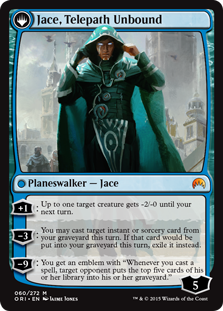 This is pretty straightforward, but I find it’s worth pointing out for a few reasons. One, as my articles are often loosely-organized semi-coherent ramblings, I find myself stopping partway through and asking myself, “What is the Application?” By that, I mean what is the takeaway for the reader. Every writer does this (consciously or subconsciously) as does every consumer of information, Magic-related or otherwise. News journalism is currently at a hyper-focused takeaway stage; gone are the long-form articles of old, replaced with 500-word mini-articles driven by clickbait taglines.
This is pretty straightforward, but I find it’s worth pointing out for a few reasons. One, as my articles are often loosely-organized semi-coherent ramblings, I find myself stopping partway through and asking myself, “What is the Application?” By that, I mean what is the takeaway for the reader. Every writer does this (consciously or subconsciously) as does every consumer of information, Magic-related or otherwise. News journalism is currently at a hyper-focused takeaway stage; gone are the long-form articles of old, replaced with 500-word mini-articles driven by clickbait taglines.
I’ve found that a delicate balance exists between “general” loose-fitting writing (the style I tend to put forth) and worthless rambling drivel. My goal is to provide information that can then be applied to a variety of situations rather than case-specific data. I use specific examples like my Grixis Control knowledge to frame these discussions with the goal that readers uninterested in Grixis can acquire a takeaway. So what’s the takeaway for these last three paragraphs? Sideboard preparation can range anywhere from basic to extensive, but every good sideboard is built on a few fundamental principles.
[wp_ad_camp_1]
Establishing Context
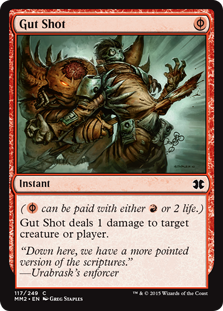 As always, Step 1 in any decision in Magic requires an understanding of the surface-level and underlying forces at work. With the assumption that an archetype has already been chosen, and a starting 60 has been completed or is close to completion, the natural starting point for a sideboard is to evaluate basic conditions and determine a few sub-factors. These sub-factors can involve matchup strengths and weaknesses, transformational strategies, and “trump” cards, but all of these are anchored by the overlying format conditions that control their use. An Ensnaring Bridge sideboard plan is pointless if everyone is playing Kolaghan's Command, or if we’re already playing a maindeck artifact combo that's weak to artifact destruction.
As always, Step 1 in any decision in Magic requires an understanding of the surface-level and underlying forces at work. With the assumption that an archetype has already been chosen, and a starting 60 has been completed or is close to completion, the natural starting point for a sideboard is to evaluate basic conditions and determine a few sub-factors. These sub-factors can involve matchup strengths and weaknesses, transformational strategies, and “trump” cards, but all of these are anchored by the overlying format conditions that control their use. An Ensnaring Bridge sideboard plan is pointless if everyone is playing Kolaghan's Command, or if we’re already playing a maindeck artifact combo that's weak to artifact destruction.
I’ve found it’s best to sketch out these ideas visually, using a tree diagram with our archetype at the top. From there, information can be organized on separate branches into archetype strengths/weaknesses, prevalent format conditions, common strategies/combos, etc. This can help us organize information and above all else establish hierarchy. Gut Shot may be an excellent card for a few specific matchups, but if the format’s Level 0 is fast combo, Gut Shot may need to be re-evaluated against other options.
Building a Database
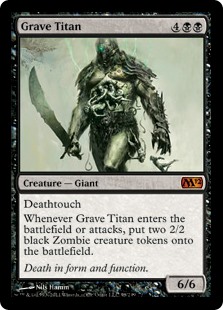 Once I have an organized collection of context to reference, I then produce a separate collection of common sideboard cards and strategies available to my archetype and color combination. Notice that I mention both, as many cards available to my archetype’s colors will still be unplayable due to my archetype’s specific characteristics (looking again to the Ensnaring Bridge example above).
Once I have an organized collection of context to reference, I then produce a separate collection of common sideboard cards and strategies available to my archetype and color combination. Notice that I mention both, as many cards available to my archetype’s colors will still be unplayable due to my archetype’s specific characteristics (looking again to the Ensnaring Bridge example above).
As we live in the digital age, there is no reason why we shouldn’t take advantage of the groundwork other players have done for us. Looking at other players’ lists is one of the best options for quickly finding data to work with. This stage is all-inclusive; meaning Grave Titan goes into our database for our 22-land archetype right alongside Seal of Fire.
Filtering and Rating
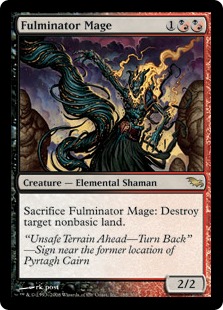 With these two lists side by side, I then sort cards into subsets based on use. Fulminator Mage, Crumble to Dust, Ghost Quarter and Molten Rain go into one subset, while Vandalblast, Kolaghan's Command, Shatterstorm and Engineered Explosives go into another.
With these two lists side by side, I then sort cards into subsets based on use. Fulminator Mage, Crumble to Dust, Ghost Quarter and Molten Rain go into one subset, while Vandalblast, Kolaghan's Command, Shatterstorm and Engineered Explosives go into another.
While the cards within a given subset accomplish similar objectives, the relative merits of one versus another can vary wildly depending on multiple factors. If we’re playing Rise // Fall then Fulminator Mage might be a better option. If we’re maximizing Jace, Vryn's Prodigy and Snapcaster Mage then we might instead consider Molten Rain. If we’re looking for high impact from only a few sideboard slots we might choose Crumble to Dust. If the rest of our sideboard is pushing our average CMC higher than normal, we might consider Ghost Quarter to bring in in other matchups and up our land count. All of these decisions come later, but beforehand we must first provide a framework upon which those decisions can be made.
Finding our Role
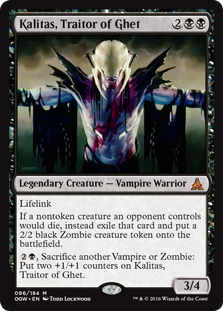 As I said in the introduction, most games will be played post-sideboard. Many players seek to perfect that starting sixty, while in reality the Game 2 and Game 3 sixty is more important. Instead of building the starting 60 and sideboard 15 as separate entities, the two should co-exist, improving and influencing each other.
As I said in the introduction, most games will be played post-sideboard. Many players seek to perfect that starting sixty, while in reality the Game 2 and Game 3 sixty is more important. Instead of building the starting 60 and sideboard 15 as separate entities, the two should co-exist, improving and influencing each other.
When time is not an issue, and I’m searching for the best list for a large tournament (or “solved” metagame) I will construct multiple lists over the course of a few days, each “post-sideboard” lists tuned for specific matchups. So, my “Grixis_v_Tron” list will have Terminates cut in favor of land destruction spells, while my “Grixis_v_Affinity” list will cut Remands and expensive spells in favor of artifact hate and more removal. Note that we still haven’t built a sideboard yet---these lists contain the best possible options for that matchup. So, the v_Affinity list will have Pia and Kiran Nalaar where the v_Tron list might have Tasigur, the Golden Fang and the v_Jund list might have Kalitas, Traitor of Ghet.
Generating lists in this way will allow us not only to find consistencies (cards that have applications in every matchup) but also to detect under-performers. Consistent contributors are much more likely to make the maindeck, while “niche” cards will be relegated to the sideboard. This gives us a general sense of what our eventual sideboard will look like. This process ensures that we’re optimizing use of our 75 slots by restricting under-performing cards and maximizing variable answers, but it doesn’t tell the whole story.
This process will also help us "gear" our maindeck towards a specific configuration. Let's look at a hypothetical situation, where Pia and Kiran Nalaar is vastly superior to Kalitas, Traitor of Ghet in the Affinity matchup (it really isn't, but assume so for the sake of this example). If we choose to play Pia and Kiran Nalaar over Kalitas, Traitor of Ghet in the maindeck, those extra points toward the Affinity matchup might let us cut a dedicated Affinity sideboard slot in favor of some card that will help another matchup.
You might be familiar with this process (pros call it "tuning") but its intricacies might often go overlooked in normal testing procedures. It might seem like a lot of work, but taking a systematic approach to tuning, treating it more like investigative research, can really push a list from "good" to "great" and beyond. Often, friends will have the "right deck" for a certain event, but end up just a few cards off and never make Day Two. A few changes here and there and they're playing in Top 8 instead of side events on Sunday.
Going further down this rabbit hole for a minute, these types of opportunities are exactly why I tend to play Blue in Modern (and Blue as a color in Magic in general). Cantrip spells like Serum Visions and Thought Scour, while not on the level of Ponder or Preordain, still let you see more of your deck over the course of the game, digging us deeper to those sideboard spells. While almost any archetype can be built to take advantage of certain sideboard spells (Abzan Company using Chord of Calling to tutor up creature bullets, Tron finding colorless sideboard spells with Ancient Stirrings), Blue almost always does this the best. In a format where knockout cards like Rest in Peace, Stony Silence, Blood Moon, and Crumble to Dust exist, the ability to dig deeper through the library to find those spells faster is key.
The Game Within a Game
 The determining factor between a solid sideboard and a great one is the dreaded re-sideboard for Game 3. We’ve all been there, when our opponent assertively scoops up and reaches back for the sideboard while we sheepishly shuffle, or worse, pretend to take a second look when we have no intention of changing a card. “What could they possibly be doing?” we think as they confidently swap cards in and out.
The determining factor between a solid sideboard and a great one is the dreaded re-sideboard for Game 3. We’ve all been there, when our opponent assertively scoops up and reaches back for the sideboard while we sheepishly shuffle, or worse, pretend to take a second look when we have no intention of changing a card. “What could they possibly be doing?” we think as they confidently swap cards in and out.
While a certain percentage of the time they’re just wasting time, the truth remains that a well-built sideboard can allow for multiple post-board configurations, even within the same matchup. We’re all aware of the “cut Mana Leak on the draw, bring it back in on the play” strategy, but the leveling goes much deeper than that.
For example, the Grixis vs. Grixis mirror can be focused on the Ancestral Vision fight or the creature removal route. Seeking to capitalize on an opposing hand full of Dispels and the like, a Snapcaster Mage-as-Ambush Viper draw can earn a quick kill against an unprepared opponent. While they are holding a hand full of control cards and Cryptic Commands, we’re beating down with creatures and using Kolaghan's Command to Shock our way to victory. Often I’ve found a strong case can be made for over half my sideboard in that matchup, and I’ll vary from 0-3 Dispel and even bring in Seal of Fire not only to kill opposing Jace’s but also to team up with Lightning Bolt and Kolaghan's Command, to kill Tasigur, the Golden Fang and Kalitas, Traitor of Ghet respectively.
Conclusion
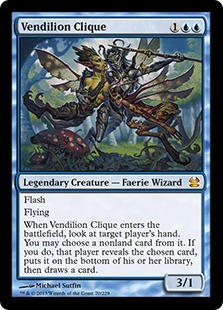 You will rarely (if ever) see me present a Vendilion Clique in any of my lists. I don’t pass it up because it’s a poor card, on the contrary I find it extremely strong in many situations. In the end, all the analysis in the world pales in comparison to playstyle and pilot familiarity. A Vendilion Clique in my hand will play vastly different from one in the hands of a more experienced pilot.
You will rarely (if ever) see me present a Vendilion Clique in any of my lists. I don’t pass it up because it’s a poor card, on the contrary I find it extremely strong in many situations. In the end, all the analysis in the world pales in comparison to playstyle and pilot familiarity. A Vendilion Clique in my hand will play vastly different from one in the hands of a more experienced pilot.
My specific reasoning for this specific card in the Grixis Control archetype comes down to a desire to limit three-plus-CMC spells, and I don’t consider Vendilion Clique to have a high enough impact to merit the slot often enough. Instead, I’d almost always choose Kolaghan's Command (the third, or even the fourth) for its numerous applications in multiple matchups.
Everyone has pet cards, my own being a singleton Bitterblossom. While I won’t include Bitterblossom in every single Grixis sideboard I make, I will try and find a way to fit it in if possible. Players unfamiliar with the card might get less traction out of it in-game, but I have enough experience with it that I find myself bringing it in for almost every matchup, even where it seems counterintuitive. What I'm trying to say is this: analyze to a point, but remember that when the list is submitted and the opening seven is drawn, even the sloppiest lists can overtake the meticulous. That’s Magic.
Thanks for reading,
Trevor Holmes
The_Architect on MTGO
Twitch.tv/Architect_Gaming
Twitter.com/7he_4rchitect




And now we are very interest to know your Grixis list 🙂
Really enjoyed reading this article and was definently a great analysis on the importance of sideboard.
Hoping to see some more videos of you on the youtube channel!